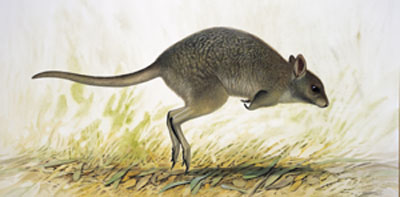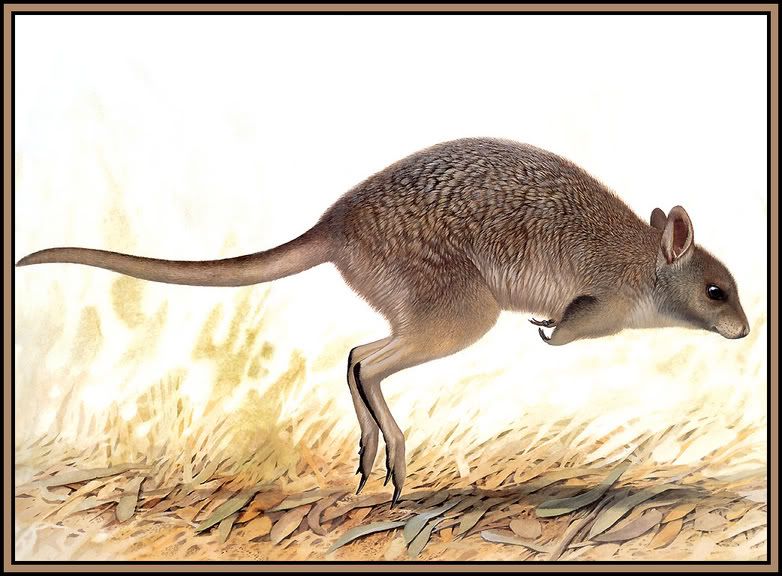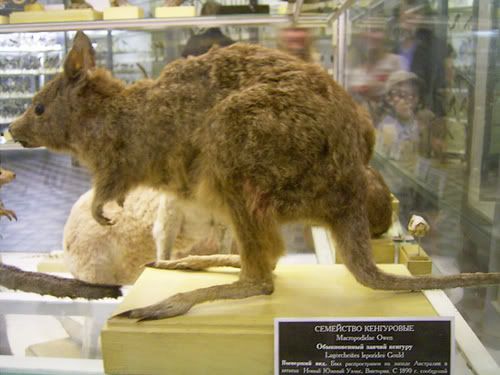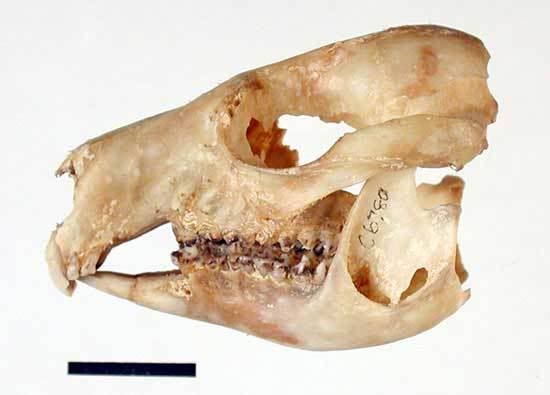|
|
Post by another specialist on Dec 5, 2006 10:49:08 GMT
EASTERN HARE-WALLABY Lagorchestes leporides It has been suggested that an important factor in the decline of hare wallabies has been alteration of grassland habitat through trampling and grazing by sheep and cattle. The removal of aboriginal Australians from large areas by European settlers may also have contributed to loss of hare wallabies by resulting in the removal of regular winter burning regimes and increasing the likelihood of devastating lightening-caused fires in summer months. This endemic Australian species has not been recorded since 1890. |
|
|
|
Post by another specialist on Dec 5, 2006 11:06:59 GMT
Eastern Hare-wallaby (Lagorchestes leporides) Distribution: Southeastern Inland Australia. Last Record: Late 1889.  This fleet and agile wallaby was once one of the most common of all marsupials on the inland plains of southeastern Australia. Its habits were rather hare-like in that by day it sat still in a well-formed ‘seat’, usually in the shelter of a tussock. If approached too closely, however, it would bound off at great speed. John Gould recorded that one animal, which had been chased by his dogs for half a kilometre ‘suddenly doubled and came back upon me…I stood perfectly still and the animal had arrived within 20 feet before it observed me, when…instead of branching off to the right or left; it bounded clear over my head.’ Another early naturalist reported that it could jump to a height of 1.8 metres, quite a feat for a hare-sized creature. The last known specimen is a female collected by a Mr K. H. Bennett of Yandenbah, via Booligal, New South Wales. The Australian Museum had dispatched a supply of spirit and collecting materials by rail to Bennett on 23 August 1889 and the specimen was received at the museum by 4 January 1890. It was the only mammal forwarded to the museum by Bennett on this occasion, arriving with a number of birds collected in the Booligal area. It was purchased for five shillings, indicating that it was perhaps already rare. Its final extinction is rather difficult to fathom as it occurred before the onset of intensive agriculture throughout its distribution, and before the fox became abundant. Perhaps competition with cattle and sheep, which before 1890 were present in unsustainably high numbers, or changed burning patterns, or the spread of cats, were decisive factors. rainforestinfo.org.au/spp/Schouten/eastern_hare.htm |
|
|
|
Post by another specialist on Dec 5, 2006 11:20:49 GMT
eastern hair wallaby  gap in nature |
|
|
|
Post by another specialist on Dec 5, 2006 11:29:04 GMT
Eastern Hare-wallaby The wallaby that dances like a hare The Eastern or Brown Hare-wallaby, Lagorchestes leporides ( Gould, 1841) lived in South-eastern Australia. In appearance, size and habits it showed some similarity to a hare. Its scientific name translates as 'hare-like dancing hare'. The famous 19th-century British zoologist and illustrator John Gould recorded that it was "tolerably abundant in all the plains of South Australia, particularly between the belts of the Murray and the mountain ranges". Gould described one of his encounters with this species. An Eastern Hare-wallaby chased by dogs ran straight towards him. Once the animal noticed the man in front of him, it did not branch off but, as Gould put it: "it bounced clear over my head". Very little is known about the habits of this wallaby except that it was solitary and made a sort of lair under a tussock of grass.  Eastern Hare-wallaby. Rapid decline The species declined rapidly in the second half of the 19th century, following European settlement in South-eastern Australia. The exact cause of extinction is unknown, but the introduction of rabbits and predators, particularly feral cats probably played an important role. The last record of the Eastern Hare-wallaby dates from 1890, when one was shot 45 km north of Booligal in New South Wales. The museum collection Museum specimens of the Eastern Hare-wallaby are rare. One of the two skins in the National Museum of Natural History, a male, was purchased in 1843 from G.A. Frank, a dealer in natural history objects in Amsterdam. The second, a female, is labelled " Murray River" ( South-east Australia). The provenance of the male is not known, nor are the collection dates of the animals. www.naturalis.nl/300pearls/ |
|
|
|
Post by another specialist on Dec 6, 2006 15:20:31 GMT
|
|
|
|
Post by another specialist on Dec 6, 2006 19:38:59 GMT
|
|
|
|
Post by another specialist on Feb 6, 2007 18:03:26 GMT
 Specimen of the Eastern Hare-Wallaby, an extinct kangaroo species from Autralia. The last specimen was seen in 1890. This species was known to have very swifty habits, outrunning dogs and jumping up to 1.50 meters high. Howeve those habits did not protect it from extinction. Introduced cats were possibly the cause for its demise. Stuffed specimen exhibited at the Natural History museum of St. Petersburg, Russia flickr.com/photos/92043060@N00/353236095/ |
|
|
|
Post by sebbe67 on Sept 3, 2007 9:02:41 GMT
|
|
|
|
Post by another specialist on Sept 3, 2007 14:32:52 GMT
|
|
|
|
Post by another specialist on Sept 3, 2007 14:36:41 GMT
|
|
|
|
Post by another specialist on Sept 3, 2007 14:40:49 GMT
|
|
|
|
Post by another specialist on Sept 3, 2007 14:43:55 GMT
 Head, showing skull and jaw side on, of an Eastern Hare-wallaby Lagorchestes leporides Specimen Reg. No. C 6789. Locality: "Mondellimin", 16km South of the junction of the Murray and Darling Rivers, Victoria/NSW Scale line equals 2cms. Photo by Marnie Rawlinson, Cathy Accurso and Ken Walker © Museum Victoria www.museum.vic.gov.au/bioinformatics/mammals/images/leposide.htm |
|
|
|
Post by another specialist on Sept 10, 2007 12:11:03 GMT
 Skin of an adult Eastern Hare-wallaby Lagorchestes leporides Specimen Reg. No. C 6458. This specimen was collected by W.Blandowski in 1857 near the junction of the Murray River and Darling River. Photo by Ken Walker © Museum Victoria www.museum.vic.gov.au/ |
|
|
|
Post by another specialist on Sept 10, 2007 14:20:54 GMT
|
|
|
|
Post by another specialist on Sept 10, 2007 19:39:31 GMT
|
|
|
|
Post by another specialist on Jan 6, 2008 22:02:20 GMT
|
|
|
|
Post by another specialist on Jul 9, 2008 3:55:42 GMT
Lagorchestes leporides Author: Gould, 1840. Actual Date: 1841 Citation: Proc. Zool. Soc. Lond., 1840: 93. Common Name: Eastern Hare-wallaby Type Locality: Australia, interior New South Wales. Distribution: Formerly W New South Wales, E South Australia, NW Victoria. Status: IUCN – Extinct. Comments: Almost certainly extinct; not recorded for more than a century (Kirsch and Calaby, 1977:22). www.bucknell.edu/msw3/browse.asp?s=y&id=11000238 |
|
|
|
Post by another specialist on Oct 11, 2008 9:50:19 GMT
Taxonomy [top] Kingdom Phylum Class Order Family ANIMALIA CHORDATA MAMMALIA DIPROTODONTIA MACROPODIDAE Scientific Name: Lagorchestes leporides Species Authority Infra-specific Authority: (Gould, 1841) Common Name/s: English – Eastern Hare Wallaby, Eastern Hare-wallaby Assessment Information [top] Red List Category & Criteria: Extinct ver 3.1 Year Assessed: 2008 Assessor/s Australasian Mammal Assessment Workshop Evaluator/s: Lamoreux, J. & Hilton-Taylor, C. (Global Mammal Assessment Team) Justification: Listed as Extinct because this species has not been recorded since 1890. History: 1996 – Extinct (Baillie and Groombridge 1996) 1994 – Extinct (Groombridge 1994) 1990 – Extinct (IUCN 1990) 1988 – Extinct (IUCN Conservation Monitoring Centre 1988) 1986 – Extinct (IUCN Conservation Monitoring Centre 1986) 1982 – Extinct (Thornback and Jenkins 1982) Geographic Range [top] Range Description: This species was endemic to south-eastern Australia. The last specimen was collected in 1890 (Strahan 2008). Countries: Regionally extinct: Australia Population [top] Population: It is presumed to be extinct. Habitat and Ecology [top] Habitat and Ecology: This little-known species appears to have inhabited open grassland plains (Strahan 2008). Systems: Terrestrial Threats [top] Major Threat(s): It has been suggested that an important factor in the decline of hare-wallabies has been the alteration of grassland habitat through trampling and grazing by sheep and cattle. The removal of aboriginal Australians from large areas by European settlers may also have contributed to loss of hare-wallabies by resulting in the removal of regular winter burning regimes and increasing the likelihood of devastating lightening-caused fires in summer months. Conservation Actions [top] Conservation Actions: Any reports of the persistence of this species, including finds of recent remains, should be investigated to determine whether it is possibly still extant. www.iucnredlist.org/details/11163 |
|
|
|
Post by another specialist on Dec 8, 2008 14:30:19 GMT
|
|
|
|
Post by RSN on Sept 1, 2011 13:44:47 GMT
|
|